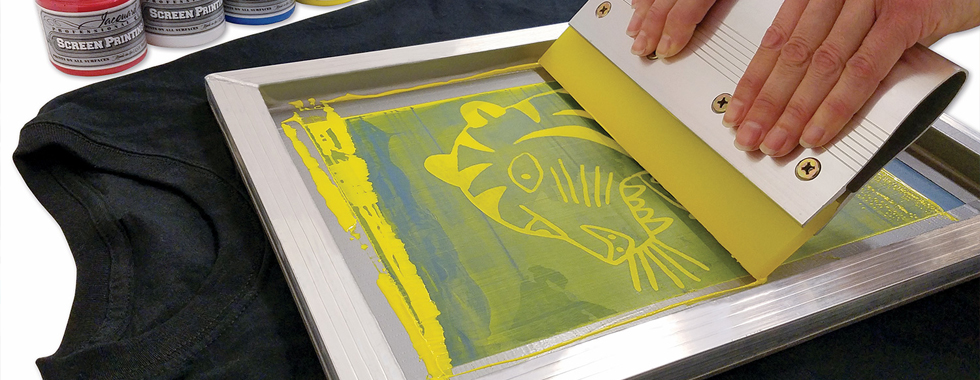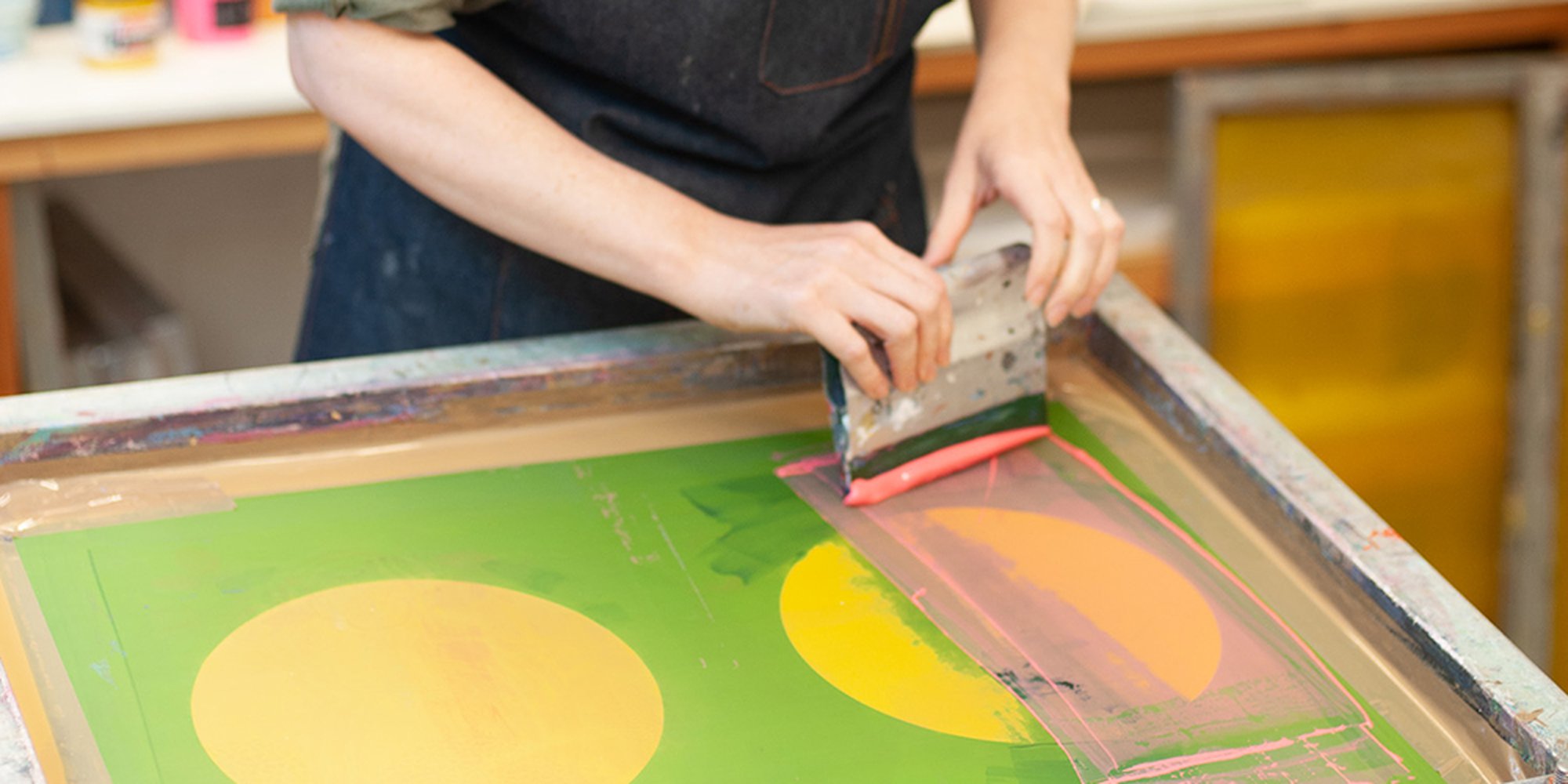ChatGPT said: 10:9 Design reviews: uncovering the pros and cons
Discover the Numerous Types of Screen Printing Techniques for Your Following Job
Screen printing supplies a varied range of techniques that can improve any type of creative task. From traditional approaches like serigraphy to modern-day technologies such as direct-to-garment printing, each strategy has its distinct benefits. Specialty choices, including metal and eco-friendly inks, present a lot more opportunities. Recognizing these strategies can significantly influence the final outcome. The difficulty lies in picking the most ideal technique for specific needs and preferred effects. What variables should one take into consideration?

The Essentials of Screen Printing
Screen printing may appear complicated, it is fundamentally a simple procedure that involves transferring ink via a mesh screen onto various surfaces. The strategy begins with the development of a pattern, which defines the style to be published. This pattern is affixed to a mesh screen, usually made from polyester or nylon. Once the stencil remains in location, ink is applied to the screen and pushed through the mesh using a squeegee, leading to the wanted pattern being printed on the underlying material.
Screen printing can be done on a vast variety of substrates, consisting of fabric, plastic, and paper, making it a versatile selection for numerous projects. The process allows for vibrant colors and detailed styles, making it prominent in markets such as advertising, style, and art. Recognizing these fundamentals equips people with the foundational knowledge required to check out advanced methods in screen printing.
Conventional Screen Printing Techniques
Conventional screen printing strategies have actually been utilized for centuries, protecting the craftsmanship and artistry of this approach. This strategy makes use of a mesh screen to transfer ink onto a substrate, such as textile or paper, enabling for dynamic and resilient styles. The procedure starts with producing a stencil, which blocks specific locations of the screen to manage where the ink will certainly be used.
One preferred strategy is serigraphy, often used for minimal editions and creative prints. Another is the use of water-based inks, which are environment-friendly and supply a soft feel on textiles - 10:9 Design Company. Additionally, typical approaches can consist of hands-on printing, where artisans use ink with a squeegee, making sure precision and attention to information
These techniques continue to be valued in the sector for their responsive top quality and the special textures they generate, attracting both consumers and makers who value the heritage of screen printing.
Digital Screen Printing Innovations
As the demand for faster manufacturing and modification in the printing market has actually surged, electronic screen printing technologies have emerged as a game-changer. This technology mixes traditional screen printing techniques with electronic procedures, permitting rapid prototyping and intricate layouts that were previously tough to accomplish. One significant improvement is the introduction of direct-to-garment (DTG) printing, which helps with premium, full-color prints on numerous textiles without the need for displays. Additionally, developments in ink formulas have brought about environment-friendly choices that keep vivid shades while reducing environmental impact. Using automated systems better improves manufacturing, minimizing labor prices and improving accuracy. These innovations not only satisfy tiny set orders and individualized styles but likewise enable quicker turn-around times, making them optimal for businesses focused on meeting client needs in a busy market. Digital screen printing, consequently, represents a necessary advancement in the domain name of printing strategies.
Specialty Screen Printing Methods
Exploring specialty screen printing approaches exposes a diverse variety of techniques that press the limits of creativity and capability in the printing industry. Amongst these, glow-in-the-dark inks provide an one-of-a-kind aesthetic effect, making styles come active in low-light conditions. Metallic inks, understood for their sparkling surface, add a touch of luxury to printed products. An additional ingenious approach is discharge printing, which removes color from the textile rather than adding ink, causing a soft, vintage feel. High-density printing produces an elevated texture externally, enhancing tactile interaction. Furthermore, water-based inks are acquiring popularity for their vivid shades and reduced ecological effect. Each of these specialty strategies satisfies certain layout requirements, enabling brand names and artists to produce standout items that reverberate with their target markets. By leveraging these techniques, services can elevate their screen printing tasks to brand-new heights, making certain unforgettable impacts.
Eco-Friendly Screen Printing Options
Green screen printing choices are acquiring traction as the sector shifts in the direction of sustainability. Sustainable ink selections and making use of naturally degradable materials are crucial components in lowering the ecological influence of the printing process. By adopting these practices, screen printers can add to a more lasting future while maintaining high-quality results.
Sustainable Ink Selections

Biodegradable Products Usage
As the screen printing market evolves, the consolidation of biodegradable materials is coming to be increasingly important for environmentally mindful practices. Producers and designers are currently discovering inks and substratums made from all-natural, renewable energies that break down much more efficiently than traditional equivalents. These biodegradable alternatives lower plastic waste and minimize ecological effect, aligning with the expanding need for lasting items.
Usual instances consist of water-based inks and natural cotton fabrics, both of which minimize damaging chemicals and promote eco-friendliness. Brands that take on these materials commonly enhance their market charm, bring in consumers that focus on sustainability. As recognition of environmental problems remains to increase, the shift towards biodegradable materials in screen printing is most likely to gain momentum, fostering a greener market requirement.
Selecting the Right Method for Your Project
Exactly how can one establish one of the most ideal screen printing method for a details job? The decision rests on a number of elements, including the product to be printed on, the intricacy of the layout, and the wanted production volume - 10:9 Design Embroidery. Direct-to-garment printing is optimal for complex designs with many shades, while conventional screen printing succeeds for bigger runs of simpler graphics.
Furthermore, factor to consider of the end-use of the published product is essential. For outdoor applications, methods that supply sturdiness and weather condition resistance, such as plastisol ink, may be liked. Conversely, environmentally-conscious tasks might take advantage of naturally degradable products or water-based inks.
Inevitably, comprehending the job's distinct needs permits for an educated option, guaranteeing both aesthetic allure and practical longevity. By assessing design complexity, material compatibility, and production range, one can efficiently select the most proper screen printing method to satisfy their task's objectives.
Frequently Asked Concerns
What Is the Background of Screen Printing?
Screen printing came from old China around 1000 ADVERTISEMENT, developing via Japan and Europe. By the 20th century, it came to be preferred in business art and fashion, transforming just how designs were created and dispersed around the world.

How Do I Prepare Artwork for Screen Printing?
To prepare artwork for screen printing, one need to ensure high resolution, make use of an ideal color mode, create different layers for every color, and transform text to outlines, ensuring compatibility with the printing procedure and preferred end result.
What Materials Are Ideal for Screen Printing?
The most get more info effective products for screen printing include premium inks, resilient screens, and appropriate substratums like cotton, polyester, or blends. In addition, utilizing appropriate solution and mops can improve the printing procedure and outcomes.
Can I Evaluate Print in your home?
Yes, screen printing in the house is possible. With the appropriate materials, configuration, and techniques, people can create top quality prints. Nevertheless, cautious consideration of work area and tools is necessary for effective outcomes.

What Are Usual Blunders in Screen Printing?
Usual errors in screen printing consist of incorrect exposure times, poor ink uniformity, misalignment of displays, not enough cleaning of materials, and overlooking to examine prints. These mistakes can compromise the quality and precision of the end product.
Screen printing might seem facility, it is essentially an uncomplicated process that involves moving ink through a mesh screen onto numerous surface areas. As the need for faster production and modification in the printing market has actually surged, digital screen printing innovations have actually arised as a game-changer. Discovering specialized screen printing techniques exposes a varied array of strategies that press the borders of imagination and functionality in the printing industry. The best products for screen printing include high-grade inks, resilient screens, and suitable substrates like cotton, polyester, or blends (10:9 Design contact). Typical mistakes in screen printing consist of improper direct exposure times, inadequate ink consistency, misalignment of displays, insufficient cleansing of products, and ignoring to check prints